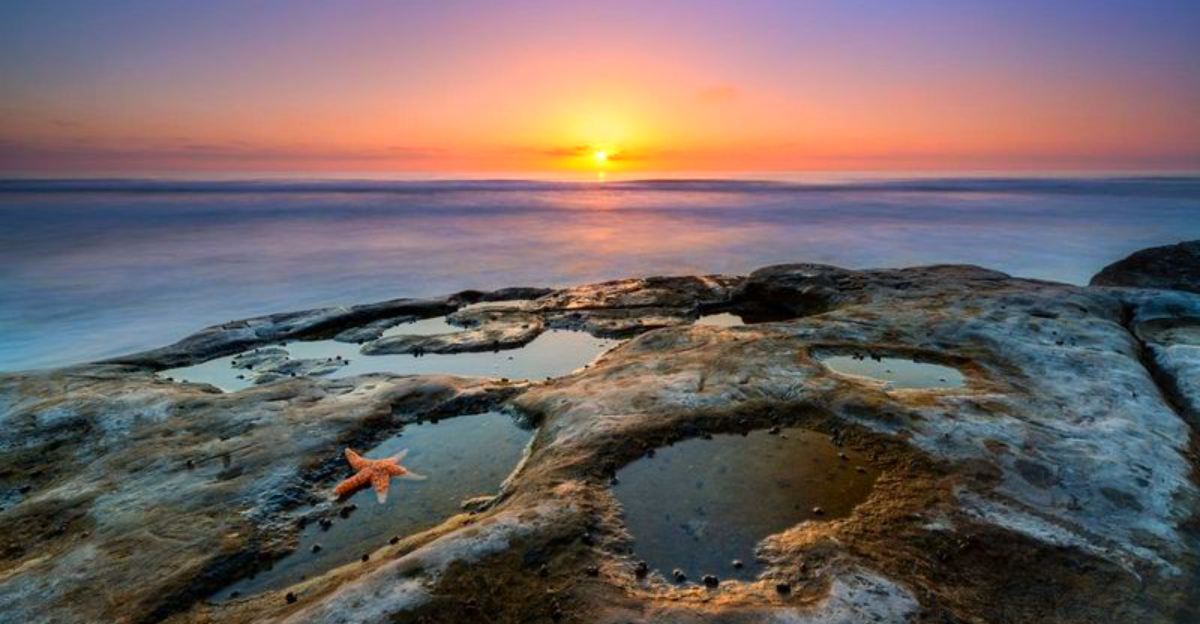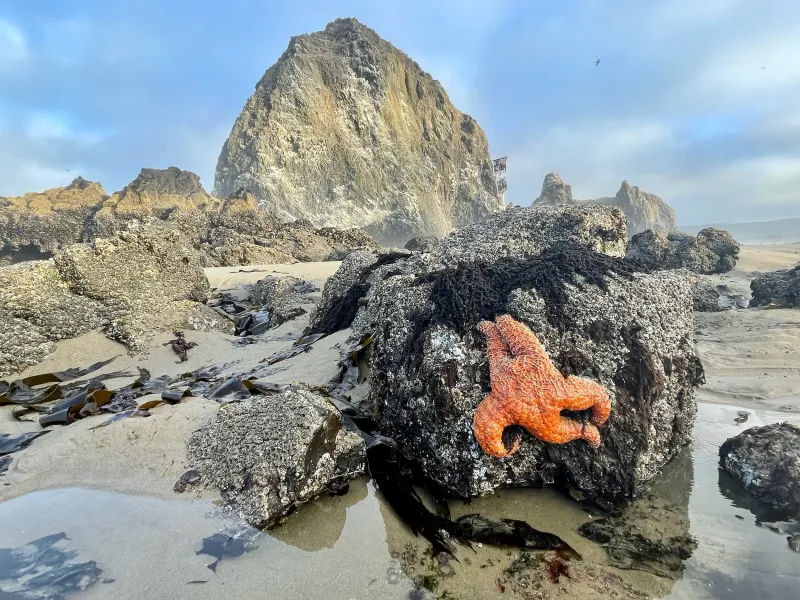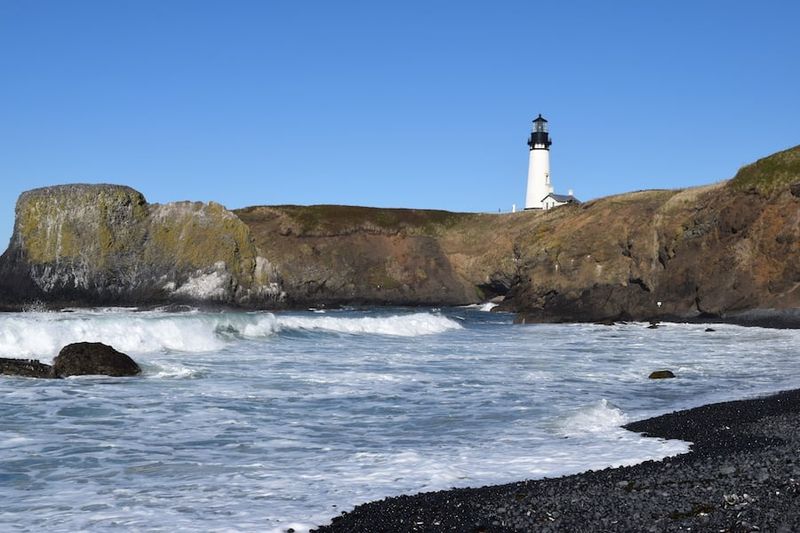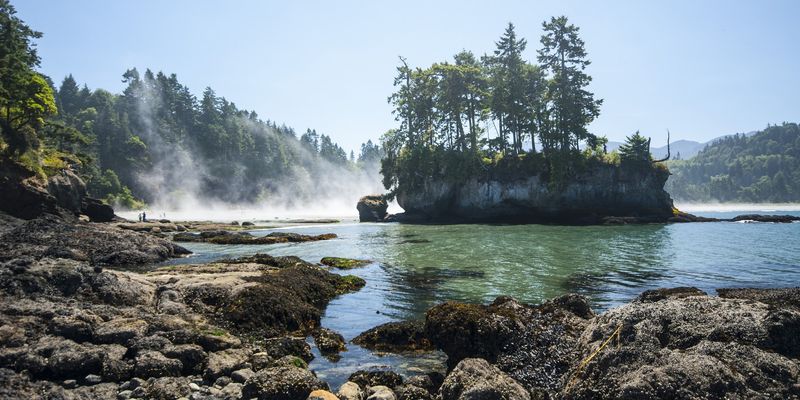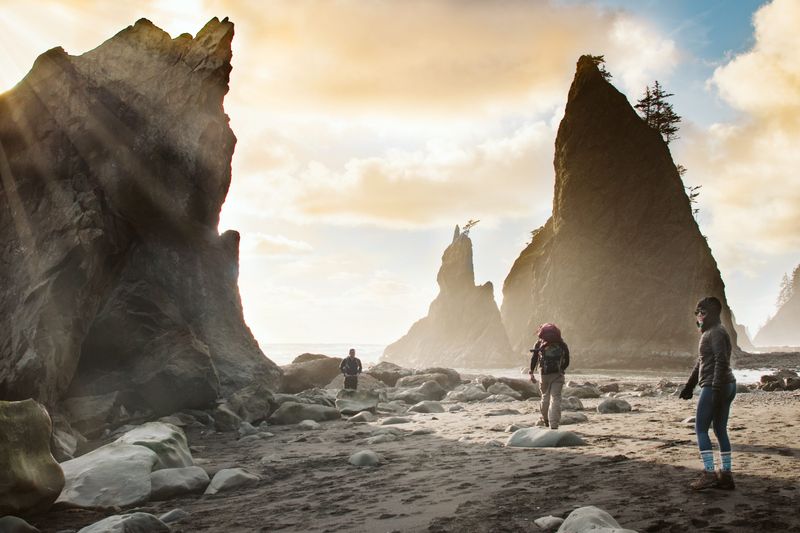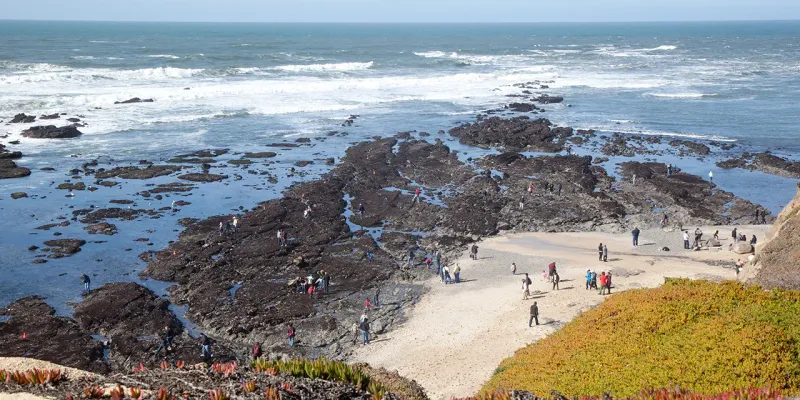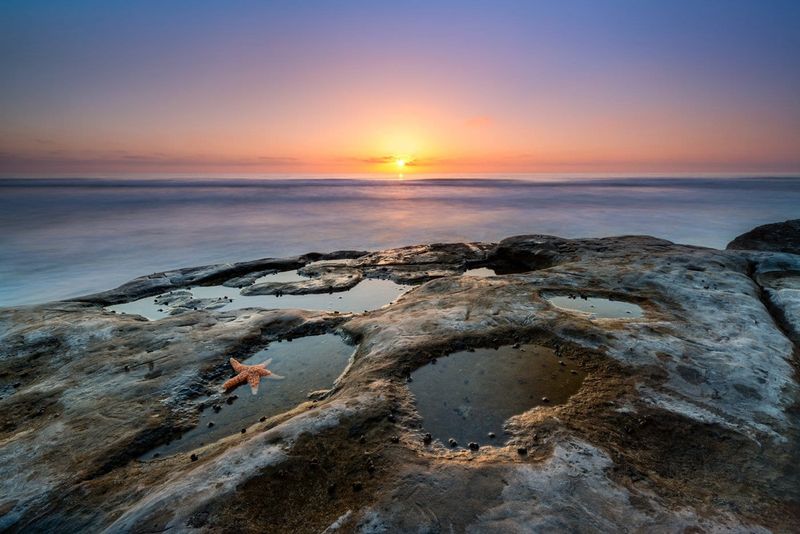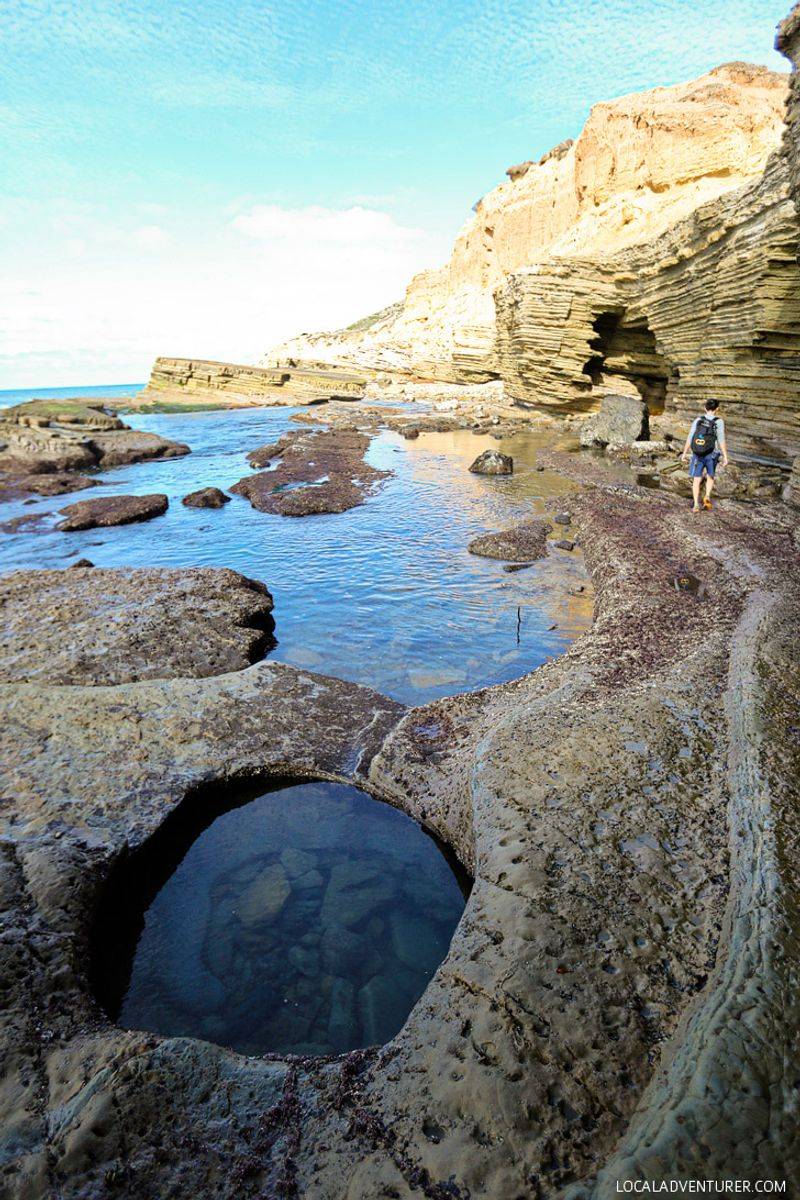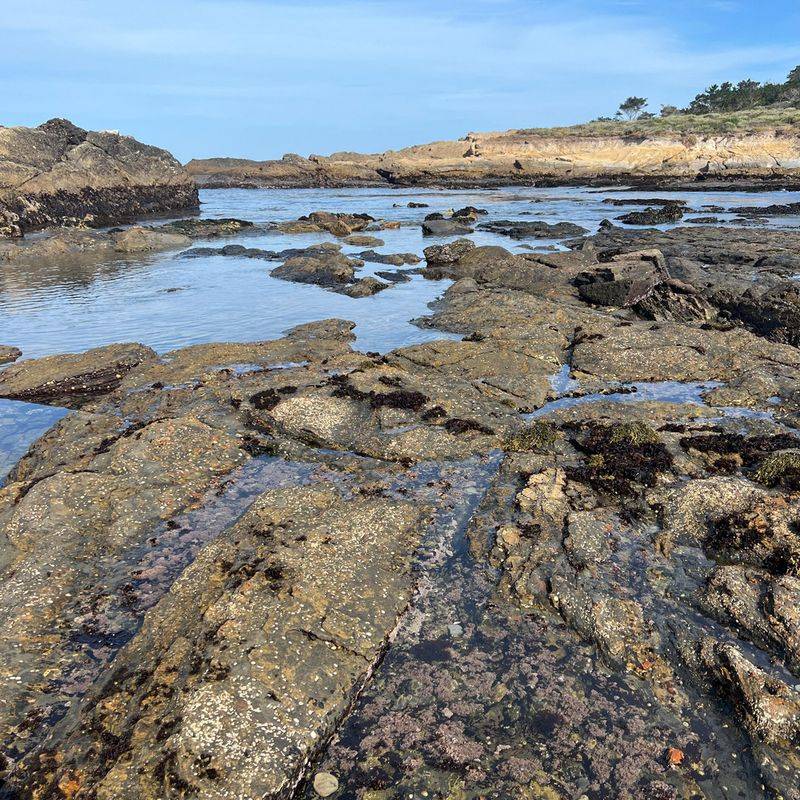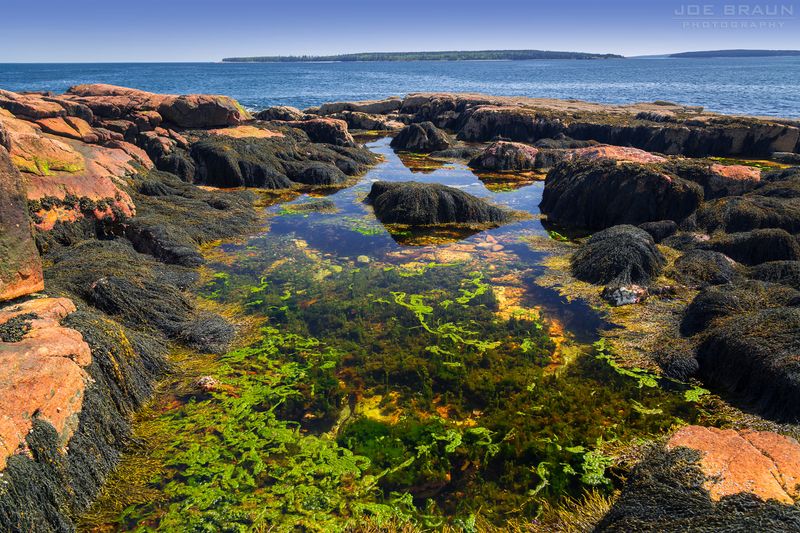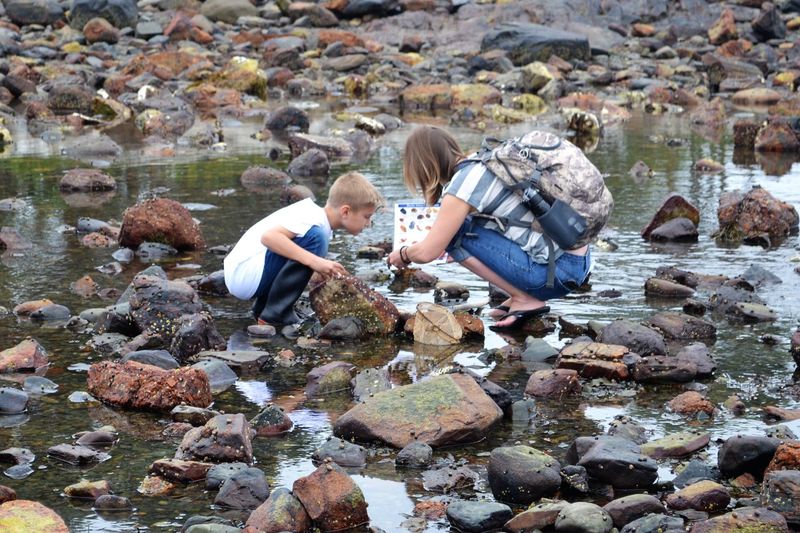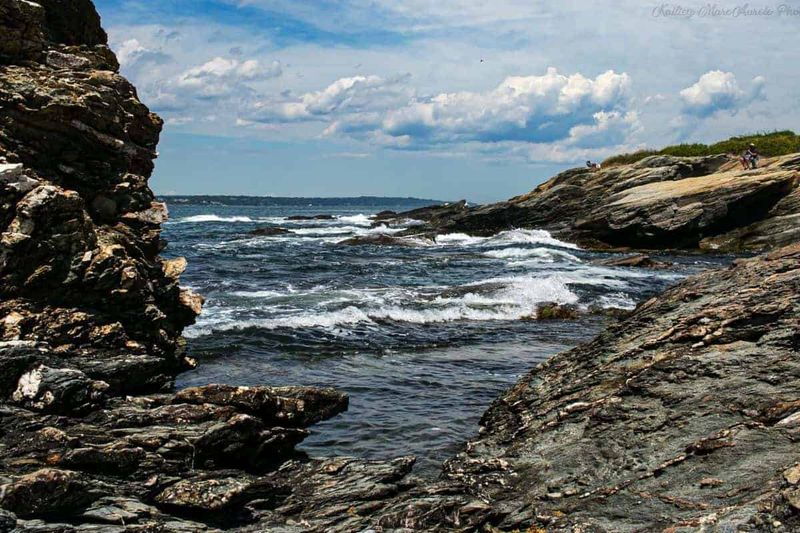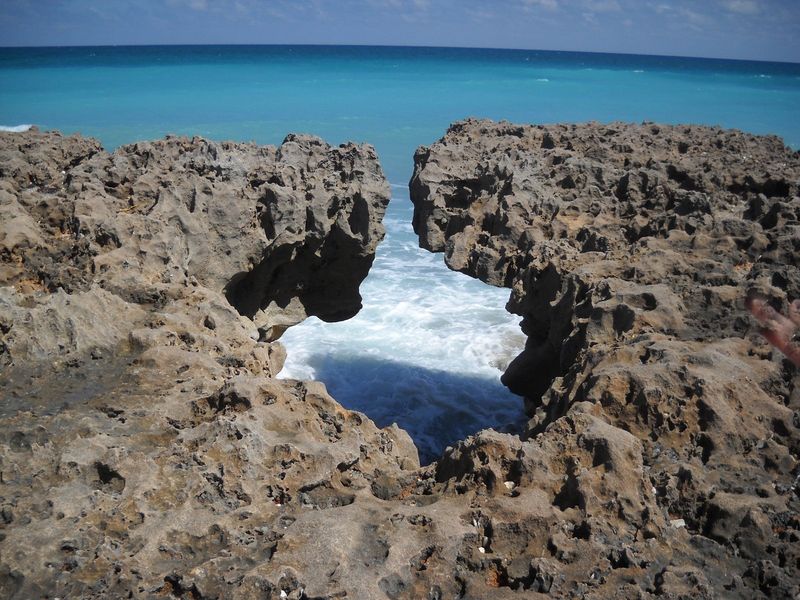Tide pools are nature’s little windows into the ocean, offering a glimpse of marine life without needing scuba gear or special training. These magical pockets of seawater form during low tide, creating temporary homes for starfish, sea anemones, crabs, and other fascinating creatures. The following locations offer some of the best tide pooling experiences in America that anyone can enjoy with just a pair of water-resistant shoes and a sense of adventure.
1. Haystack Rock, Cannon Beach, Oregon
Towering 235 feet above the shoreline, Haystack Rock transforms into a wildlife wonderland during low tide. The surrounding pools teem with colorful sea stars, spiky purple urchins, and gently swaying green anemones that close like flowers when touched.
Friendly volunteers from the Haystack Rock Awareness Program often station themselves nearby from March through October, pointing out hidden creatures you might otherwise miss. Their telescopes sometimes spot puffins nesting on the rock’s upper ledges!
Access couldn’t be simpler – park in town and stroll across the flat, sandy beach. Just remember to check tide tables before visiting and never turn your back on the ocean.
2. Yaquina Head Outstanding Natural Area, Newport, Oregon
Beneath the watchful eye of Oregon’s tallest lighthouse stands a volcanic wonderland of tide pools. The dramatic black basalt formations create perfect pockets for marine life, especially in the area known as Cobble Beach, where smooth, round rocks replace typical sand.
Orange and purple sea stars contrast vividly against the dark rocks, while tiny hermit crabs scuttle between crevices. Green anemones wave their tentacles like underwater flowers, waiting to snare passing food.
What makes this spot special is the accessibility – a paved path leads to viewing platforms, and interpretive rangers often guide visitors during summer months. The BLM maintains excellent facilities, including restrooms and an educational center explaining the area’s geology.
3. Tongue Point, Salt Creek Recreation Area, Washington
Ancient lava flows created the perfect tide pool playground at this hidden gem on Washington’s Olympic Peninsula. Unlike more touristy spots, Tongue Point often provides a peaceful experience where you’ll share the broad, flat reef with more seagulls than people.
The county park setting offers convenient amenities while protecting some of Washington’s most diverse marine habitats. Bright purple and orange sea stars cling to rocks alongside giant green anemones and scurrying crabs.
A short trail from the parking area leads to the rocky bench that emerges at low tide. The harvest prohibition means everything stays undisturbed for your viewing pleasure. Bring a field guide to identify the countless species that make these pools their home.
4. Rialto Beach (Hole-in-the-Wall), Olympic National Park, Washington
Driftwood sculptures dot the shoreline as you embark on this magical beach walk to one of the Pacific Northwest’s most photogenic tide pool areas. The journey itself – roughly 1.5 miles of flat, pebbled beach – builds anticipation for the grand finale: a massive stone arch surrounded by life-filled pools.
When low tide reveals the passage through Hole-in-the-Wall, you’ll discover a kaleidoscope of marine creatures clinging to the rocky surfaces. Bright green anemones contract when gently touched, while ochre sea stars and purple urchins create splashes of color against dark stones.
Park rangers recommend planning your visit around the lowest tides and beginning your return journey as the tide starts to rise. The beach’s wild, misty atmosphere adds a sense of adventure to this accessible exploration.
5. Fitzgerald Marine Reserve, Moss Beach, California
Morning fog often shrouds this coastal treasure near San Francisco, creating a mystical atmosphere as you discover its underwater secrets. The extensive reef platform stretches before visitors like an alien landscape when the tide retreats.
Brilliant red and purple sea stars contrast against emerald green anemones, while octopuses occasionally make appearances in deeper pools. Harbor seals frequently lounge on offshore rocks, curiously watching the human visitors.
Rangers and volunteer docents often patrol the reserve, offering insights about the delicate ecosystems and ensuring visitors follow the strict look-don’t-touch policy. The relatively flat approach from the parking area makes this an ideal spot for families and first-time tide pool explorers to witness California’s marine biodiversity without breaking a sweat.
6. La Jolla Tide Pools (Dike Rock, Shell Beach & more), San Diego, California
Urban tide pooling reaches its peak at La Jolla, where several prime spots dot the coastline of this upscale San Diego neighborhood. Winter brings the lowest tides during daylight hours, revealing hidden underwater worlds just steps from bustling streets and cafes.
Shell Beach showcases tiny fish darting between eel grass, while Dike Rock – a favorite study site for Scripps Institution scientists – features an impressive array of sea hares, nudibranchs, and other exotic creatures. The Children’s Pool area offers glimpses of sea lions lounging nearby.
Convenient street parking and easy beach access make these pools perfect for spontaneous exploration. The contrast between the sophisticated town setting and the primitive marine ecosystems creates a uniquely accessible nature experience that requires no special planning or equipment.
7. Cabrillo National Monument Tidepools, Point Loma, San Diego, California
Perched at the tip of Point Loma peninsula, these protected pools offer both stunning ocean views and incredible biodiversity. The dramatic sandstone formations create a labyrinth of pools where five distinct marine zones can be explored within a relatively small area.
Lucky visitors might spot bright orange garibaldi fish – California’s state marine fish – darting between rocks. Green sea anemones, purple urchins, and countless mollusks create a living mosaic against the golden cliffs.
The National Park Service maintains excellent trails down to the shore, with informative signage explaining the creatures you’ll encounter. Rangers frequently conduct educational programs during peak seasons. The combination of well-maintained facilities and untamed nature makes this an ideal introduction to tide pool ecosystems.
8. Point Lobos (Weston Beach), Carmel/Monterey, California
Artists and photographers have long been drawn to Weston Beach, named for famed photographer Edward Weston who captured its otherworldly beauty. The swirling patterns in the ancient rocks create natural frames for the abundant tide pools that form during low tide.
Sea otters frequently frolic just offshore, while harbor seals bask on nearby rocks. The pools themselves harbor a dazzling array of life – from tiny sculpin fish to giant green anemones and purple sea urchins that look like living pincushions.
A short, well-maintained trail leads from the parking area to this protected beach within the larger reserve. Arrive early to secure parking (the reserve limits vehicles) and time your visit with low tide. The Monterey Bay Aquarium often recommends this spot for families wanting to see wild versions of their exhibit creatures.
9. Wonderland & Ship Harbor, Acadia National Park, Maine
The Atlantic coast offers a completely different tide pooling experience than the Pacific, and Acadia National Park showcases the best of New England’s marine life. The granite-dominated shoreline creates perfect depressions for tide pools teeming with northern species rarely seen elsewhere.
Periwinkle snails and barnacles carpet the rocks, while northern red anemones add splashes of color. The real prizes are the lobsters – young ones often hide in deeper pools before moving to offshore waters as adults.
Both Wonderland and Ship Harbor trails provide easy, family-friendly paths through fragrant pine forests before opening to the rocky shore. The dramatic tidal range in Maine – often 10-12 feet – creates especially large pool areas during low tide. The cool, clear waters offer perfect visibility for spotting creatures without getting more than your feet wet.
10. Odiorne Point State Park (Seacoast Science Center), New Hampshire
New Hampshire may have the shortest coastline of any coastal state, but it packs impressive marine diversity into Odiorne Point’s rocky shores. The 1.5-mile stretch of rugged coastline harbors countless pools where cold-water species thrive in the Gulf of Maine’s nutrient-rich waters.
Blue mussels cluster in massive colonies, while rock crabs scuttle sideways between crevices. Look carefully for well-camouflaged winter flounder – flat fish that change color to match their surroundings – resting on pool bottoms.
The on-site Seacoast Science Center elevates this experience with touch tanks, educational exhibits, and guided tide pool tours during summer months. Paved paths and packed gravel trails make access straightforward for visitors of all abilities. The park’s WWII military history adds an interesting cultural dimension to your natural exploration.
11. Beavertail State Park, Jamestown, Rhode Island
Rhode Island’s oldest lighthouse provides a picturesque backdrop for some of New England’s most accessible tide pools. The sloping rock shelves surrounding the point create perfect conditions for pools of varying depths, each hosting different marine communities.
Asian shore crabs – an invasive species with distinctive square shells and banded legs – have become common residents alongside native species like rock gunnels (slender fish that resemble eels) and northern star coral. The park’s location where Narragansett Bay meets the Atlantic Ocean creates a mixing zone where diverse species thrive.
Several parking areas allow visitors to choose different sections of shoreline to explore. The Beavertail Aquarium operates seasonally inside a historic building, offering close-up views of local species and educational programs. The flat approach to most pool areas makes this an especially family-friendly destination.
12. Blowing Rocks Preserve, Jupiter Island, Florida
Florida’s contribution to America’s tide pool landscape offers something completely different: ancient coral reef transformed into limestone riddled with holes, caves, and pools. During high tide, waves crash through these openings, creating dramatic water spouts that give the preserve its name.
Low tide reveals countless small pools harboring tropical species rarely seen in mainland U.S. tide pools. Colorful blennies – tiny fish with expressive faces – peer from holes, while bright red and orange sponges add Caribbean color to the weathered white limestone.
The Nature Conservancy maintains excellent facilities, including boardwalks and an educational center explaining the unique geology. A short, signed trail leads to the beach area. The preserve showcases native coastal plants restored to their natural state, creating a complete ecosystem experience beyond just the marine life.
